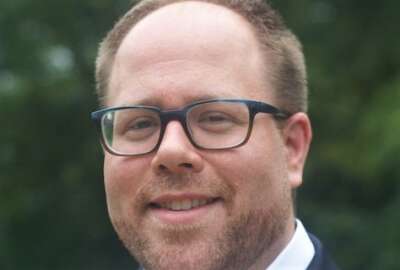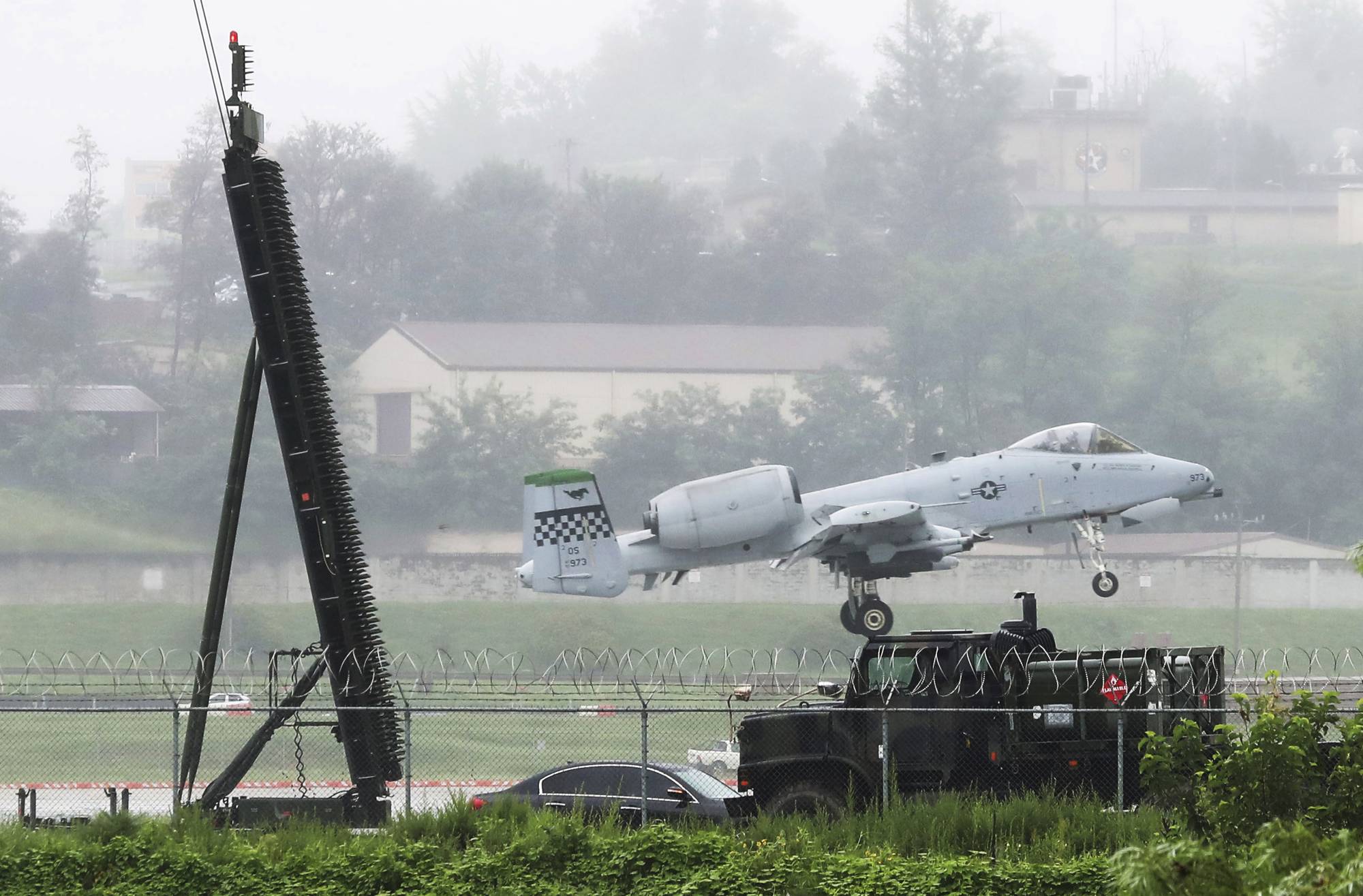A new way for the Air Force to make sure good ideas don’t get lost in the clouds
Through the Lab's Air and Space Forces Science & Technology Front Door Project officials hope to nurture partnerships with S&T experts
Best listening experience is on Chrome, Firefox or Safari. Subscribe to Federal Drive’s daily audio interviews on Apple Podcasts or PodcastOne.
Einstein once said, “If at first the idea is not absurd, then there’s no hope for it.” Well, the Air Force Research Laboratory seems to be taking that to heart. Air Force technology officials want to make sure that if they hear a good idea to solve a challenge, they’ll be able to bring that idea to fruition. Through the Lab’s Air and Space Forces Science & Technology Front Door Project officials hope to nurture partnerships with S&T experts to do just that. For more, Federal News Network’s Eric White spoke with two of the Lab’s science and technology leads Elizabeth Escamilla and Brian McJilton, on Federal Drive with Tom Temin.
Interview transcript:
Brian McJilton: One of the big things that we’ve learned all the S&T strategy early on, or at least the strategy efforts early on, through a lot of our engagements with academia and industry through what we call ideation events was several things. We are not a known commodity out in the ecosystem. What I mean is that AFRL is not that broadly well known within the S&T ecosystem, as you would see a NASA or another large organization. And so as we started having engagements with universities and other small businesses, it became very apparent that many of these organizations really, were very ill equipped to understand what our needs were, or even understand what our mission is, as an Air Force organization supporting two services, both the Air and the Space Force. So we have underneath the S&T tasking and the strategy implementation, identified a number of lines of efforts that helped us take action against a lot of the go do’s that we’re seeing in the S&T strategy. And primarily, a lot of go do’s have – the focus on how we develop and deliver transformational capabilities. And we have a new organization that was stood up to help support that which is called a transformational capability office.
But underneath objective three, which was deepening and expanding the S&T enterprise, we had a number of initiatives that we’re looking at how do we engage differently with the S&T ecosystem? How do we enable ourselves to better connect with that ecosystem to elicit their ideas, elicit their inputs, their thoughts, and even their solutions and bring those to the right people inside Defense, to determine whether or not we can continue to collaborate and partner with these folks to deliver new solutions, new capabilities that are not only going to address maybe some of the capabilities we have, with our Air Force, our Space Forces today, but also deliver new capabilities that are going to give us considerable advantages over adversaries in the future for our warfighters. And that, quite honestly, is one of the key things that was done out of S&T 2030 strategy was the development of the Air Force Tech Connect capability.
Eric White: Yeah, Liz, can you tell me specifically about these kinds of relationships that are being formed through this front door model?
Elizabeth Escamilla: So I’m going to kind of take one step back before I actually go into kind of the relationships that are being formed, just to kind of give a little bit more detail on kind of the, science and technology front door. The S&T Front Door, or Tech Connect, it was developed by Air Force Research Lab, and it was developed as a service to connect potential partners with both Air Force and Space Force science and technology. Not only experts, but also opportunities, because when you read the strategy, and you understand, where it specifically talks about the front door that’s under objective three – and Brian was just talking about that – There’s a sub-objective under objective three. Objective three was the expand the science and technology ecosystem. There’s drive innovation through these partnerships, so that we need to leverage industry, small business, entrepreneur, individual ideas, technologies, tools, solutions, and bring them into the Air Force/Space Force to have more potential transformational impact.
So a lot of the problems that [are] described in the strategy, it says that, many potential partners have difficulty in navigating our structure, they don’t know how to connect to us, connect with us. So I always say that, we listened, we saw that it was pointed out in the strategy, we listened, and we’ve improved, we’ve built a business model. And that’s where the Front Door, Tech Connect has come from. And over the last 18 months, we’ve evolved this Air Force and Space Force Tech Connect website to have that more comprehensive look into the science and technology ecosystem and so that we can improve how we’re connecting potential partners to ensure those innovations have that transformational impact. So when you ask me about, how we are doing these partnerships, so we’re finding and seeing partnerships happen and collaborations happening through the unsolicited idea submission intake pipeline.
So it is an idea pipeline. It’s a new business model, where you use the website, you have a human in the loop, we have a Tech Connect team, that triages, that looks at – that reviews every submission that comes through the front door through the Tech Connect website and provide feedback. They pull the thread on the technology or the solution or the submission that’s coming through to better understand exactly what the capabilities are. And then with discussions, even amongst the team, is there value added and continuing those discussions and setting up meeting with certain program areas with certain subject matter experts to really see if there are potential collaborations or potential partnerships that may happen moving forward?
Eric White: How important is that connection in the AFRL’s overall mission and maintaining relationships with new innovators and not just going back to the well for some of the people that you’re more familiar with? Brian, maybe you might have some insight on that one?
Brian McJilton: Yeah, I think it’s huge. And so, again, I’ll reflect back to one of the things that was just an eye opener to me early on in our S&T 2030 engagements. We had these ideation events to where we brought our S&E’s out external to the laboratory. And we conducted these events at universities, where we were bringing scientists from regions of the United States to converge on different challenge, technical topics, and collaborating through multi-disciplinary discussions, ways that we could attack the challenge through convergence of solutions of ideas. And, that was an eye opener to – I mean, our S&E’s are always looking at, what is new and evolving out in the ecosystem. And they are very aware and very engaged in cross multiple disciplinary discussions, and through research and other activities.
But it would just really highlighted the fact that, we can, like you said, we can continue to go back to the same well with some of the the trusted key innovators that we work with, but there is always new fresh ideas that are emanating out of universities, in the business sectors, because again, competition is huge out in the business sector, and they are always looking at what is going to give them advantage over their other competitors that, to keep your business going, right? And so we as S&T innovators ourselves, have to continually be connected into that ecosystem, to leverage those those innovative ideas.
Eric White: Liz, any success stories that come to mind when you think of how well this program has worked?
Elizabeth Escamilla: Oh, absolutely, there’s quite a few, maybe I can just highlight two that I’ve seen, definitely in kind of the more recent submissions? So there was a small business submission that came through the Tech Connect website. And it was definitely more on the Sensor side. And we had a subject matter expert from Sensor say, “Hey, what, there’s a really cool uniqueness to what they’re doing.” And actually what they’re doing is a maybe – I’m just gonna call it like solution A and solution B. They bring solution B to the table, and we’re already working with another company that has solution A, and if we can get these two companies to work together, which ultimately they did, they sign nondisclosure agreements. And together, they had a capability that met an Air Force gap. So of course, that’s a “rah-rah” win. But it wouldn’t have been identified if we didn’t have the transparency that we had in this platform, that submission either, maybe just not on this timeframe would have reached Air Force Research Labs, but it might have actually maybe reached kind of the wrong connection person. When I say connection person is, prior to having this platform, somebody may come to Liz and say, “Hey, I have this wonderful tool, technology and idea.” And I’m pretty well-connected with an Air Force Research Lab. However, I’m also limited to my own personal Rolodex of connections. So I might then like, “Hey, that sounds cool. But either I tried to connect, or I couldn’t find a connection, sorry.” That might have been turned away, unintentionally, whereas this method, this business model allows that transparency so that other folks can see. And so that Sensors director was like, this was great. So they just have an Air Force kind of capability potentially being met through the combination of these two companies.
Another one was one of our large kind of industry partners who had already worked with Air Force Research Lab before, their R&D department heard through word of mouth about Tech Connect, and they said, huh? First of all, they wanted to challenge us and so they submitted four kind of different ideas. Some of them were very basic research and another one was a higher kind of technology readiness level to see if it was ready for incorporation into Air Force. There was a uniqueness there, another Tech Connect team member said, hey, I want to jump on a call with them. Instead of giving them four separate feedback, let’s go ahead and get on a phone call. And after that discussion happened, I can’t talk about the kind of ID or technology because they’re still, working on it. But they gave technical feedback as far as the direction and that industry partner said, that was an awesome experience. Thank you very much for the time and effort and by the way, we got back to them within 24 hours. They said that was a wonderful direction of what we’re doing is we’re going to pivot the direction we were going. It doesn’t completely change our R&D direction. But what we are going to do now will be back to y’all in about a year. And we are closer to meeting the mark now after this discussion than where we were before this discussion.
Copyright © 2025 Federal News Network. All rights reserved. This website is not intended for users located within the European Economic Area.
Tom Temin is host of the Federal Drive and has been providing insight on federal technology and management issues for more than 30 years.
Follow @tteminWFED






